الأسواق
عند تصميم تدخل إنساني وتحديد ما إذا كان سيتم استخدام المساعدات النقدية والقسائم، يجب أن يكون تحليل السوق جزءًا من تحليل الاستجابة الشامل. وثبت أن دعم الأسواق للعمل بشكل جيد يؤدي إلى تعافي أسرع وزيادة المرونة في المناطق المتضررة من الكوارث.
واستثمرت العديد من المنظمات في تطوير أدوات لدعم تحليل السوق وتفكر في البرمجة القائمة على السوق بشكل أكثر شمولية. يشمل ذلك التدخلات التي تستخدم السوق (مثل التحويلات النقدية إلى السكان المتضررين)، بالإضافة إلى التدخلات التي تدعم الأسواق بشكل مباشر (مثل المنح المشروطة للمتداولين لإعادة تشغيل أسواقهم).
Related initiatives
Featured content

Introduction to Market Analysis
دورة تدريبية
This 30 minute online course provides an introduction to the analysis of markets in emergency contexts, with input from some of the world’s leading thinkers on the topic.

A Practical Guide to Market Analysis in Humanitarian response
دورة تدريبية
A three to four hour online course designed to provide future humanitarian market assessment team members with a solid understanding of theory and steps of market assessments so that they can join assessment teams prepared with a basic understanding of what they will be doing and why.
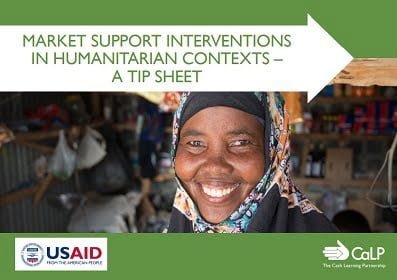
Market Support Interventions in Humanitarian Contexts – a Tip Sheet
Guidelines and Tools
This tip sheet defines what market support programming in humanitarian contexts is, and what it can look like in practice. It enables humanitarian practitioners to systematically consider market support interventions alongside other programme activities. The scope includes support interventions focusing on supply/availability and on demand/access. The tip sheet is based on secondary data...
Latest
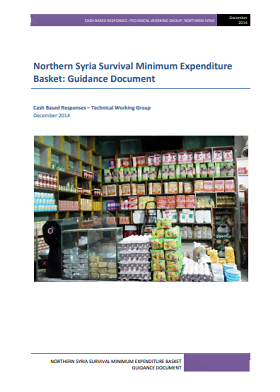
Northern Syria Survival Minimum Expenditure Basket: Guidance Document
Report
The Survival Minimum Expenditure Basket (SMEB) outlines the minimum culturally-adjusted items for survival for a household in Syria for one month. The basket comprises the basic energy requirements of 2,100 kilocalories per person per day, fuel for cooking, and non-food items. The attached guide has been...
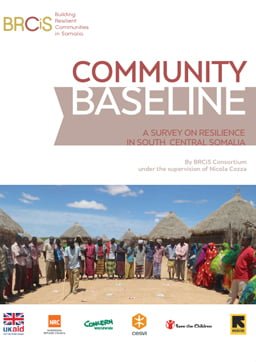
Community Baseline: A Survey On Resilience In South Central Somalia
Report
A comprehensive understanding of the socio-economic and environmental context of intervention is essential to the success of any resilience-building program. Based on this premise, the BRCiS has taken a series of steps to strengthen its knowledge and understanding of key variables and dynamics in its...

Payment Mechanisms and Anti-Poverty Programs: Evidence from a Mobile Money Cash Transfer Experiment in Niger
Report
Cash transfers have become an increasingly important component of social protection policies in both developed and developing countries. While such programs are often implemented electronically in developed countries, in many developing countries with weak financial infrastructure, such transfers are...
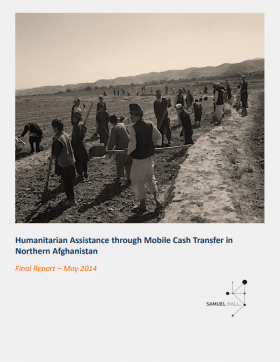
Humanitarian Assistance through Mobile Cash Transfer in Northern Afghanistan: An evaluation of a DFID pilot project in Faryab, Jawzjan, and Samangan
Report
In response to the 2011 severe drought that pushed vulnerable rural households into food insecurity in 14 provinces of Northern Afghanistan, DFID has committed to address emergency needs in northern Afghanistan with nutrition, food security and farming inputs. Samuel Hall Consulting, a Kabul-based...
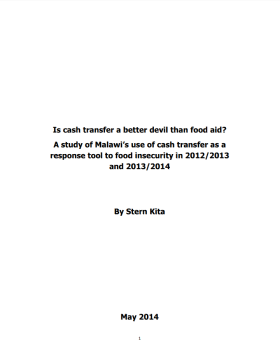
Is Cash Transfer a Better Devil than Food Aid? A study of Malawi’s use of cash transfer as a response tool to food insecurity in 2012/2013 and 2013/2014
Report
The 2004 Indian Ocean Tsunami is considered as the first humanitarian situation where cash transfers were used as an alternative to food aid. Since then, cash transfers have been used as a standalone response tool to disasters, or used in combination with food aid. Malawi piloted the use of cash...

The EU and Social Protection in Africa
Report
The European Report on Development recommends that the EU should make social protection an integral and central component of its development policy. But what can the EU bring to the social protection agenda of African and other developing countries?

Rapid Assessment for Markets (RAM) – Guidelines for an initial emergency market assessment
Guidelines and Tools
In today’s world, people’s livelihoods depend to a significant extent on markets. Sudden shocks can severely limit how markets function and, as a result, drastically reduce people’s access to essential commodities. This International Red Cross and Red Crescent Movement publication is designed to...

Community Baseline: A Survey On Resilience In South Central Somalia Summary
Report
A comprehensive understanding of the socio-economic and environmental context of intervention is essential to the success of any resilience-building program. Based on this premise, the BRCiS has taken a series of steps to strengthen its knowledge and understanding of key variables and dynamics in its...
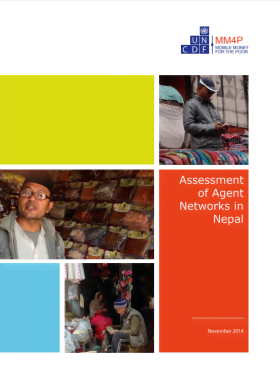
Assessment of Agent Networks in Nepal
Report
This report focuses on assessing the existing agent networks in Nepal, so that the correct steps can be taken to popularise both access to and use of financial services through bank-led agent banking. After the release of electronic banking regulations in 2012, many financial institutions began...
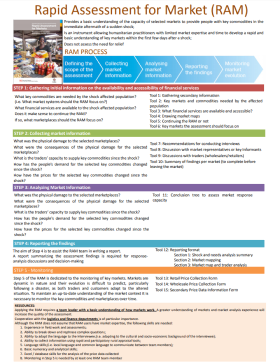
Poster – Rapid Assessment for Market (RAM)
Guidelines and Tools
This poster provides a basic understanding of the capacity of selected markets to provide people with key commodities in the immediate aftermath of a sudden shock. It is an instrument allowing humanitarian practitioners with limited market expertise and time to develop a rapid and basic understanding of...
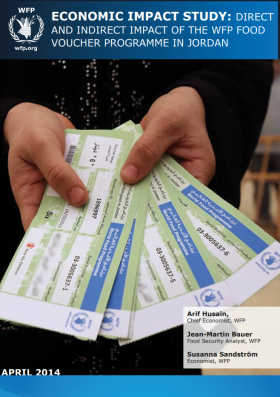
Economic Impact Study: Direct and indirect impact of the WFP food voucher programme in Jordan
Report
The intent of this study is to estimate the economic benefits of the food voucher programme implemented by the World Food Programmeme (WFP) for Syrian refugees in Jordan. The study employs a two pronged approach whereby the first component provides an analysis of the supermarkets that participate in...

Does one size fit all? The Conditions for Conditionality in Cash Transfers
Presentation
Created in the early 1990s in Latin America, Conditional Cash Transfer programmes (CCTs) are now at the forefront of the international policy debate as one of the most effective social interventions for tackling poverty in developing countries. However, if CCTs have been successful in achieving some of...
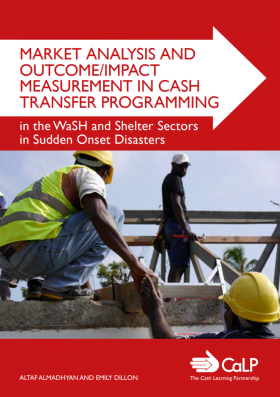
Economic Impact Study: Direct and Indirect Effects of the WFP Value-Based Food Voucher Programme in Lebanon
Report
This study examines the direct and indirect impacts of WFP’s e-card programme on the Lebanese economy. It is part of a broader United Nations initiative to assess the economic impacts of humanitarian assistance in Lebanon. The e-card programme is an important element of the international humanitarian...

Cash transfer programming – an introduction (low resolution video)
Video
Since 2010, the European Commission’s Humanitarian Aid and Civil Protection department has been supporting a partnership between IFRC, the CALP Network and British Red Cross. The partnership seeks to use cash where it’s appropriate and to help ensure that the humanitarian community has the skills...

Support to the local tool market post-Typhoon Haiyan
Report
Super Typhoon Haiyan struck Leyte and Eastern Samar in the Philippines in November 2013. CRS responded by initiating a program in 2014 to support the livelihoods recovery of 5,250 agriculture-based households. The Livelihood Early Recovery Support to Agricultural Households Affected by Typhoon Yolanda...
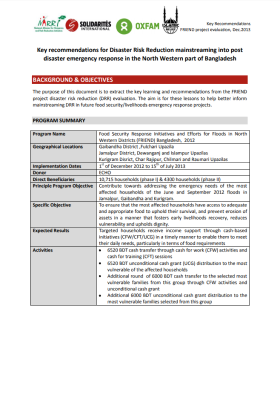
Key Recommendations for Disaster Risk Reduction Mainstreaming into Post Disaster Emergency Response in the North Western Part of Bangladesh
Policy paper
From December 2012 to July 2013, three NGOs from the National Alliance for Risk Reduction and Response Initiatives consortium (Solidarités International, Islamic Relief and Oxfam) implemented a Food Security response after flash floods that occurred in the North Western districts of Bangladesh. The...
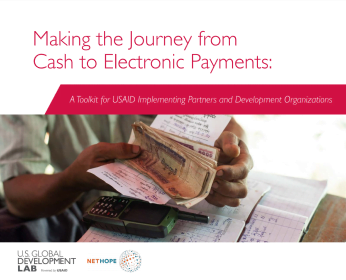
Making the Journey from Cash to Electronic Payments: A toolkit for USAID implementing partners and development organizations
Guidelines and Tools
This Toolkit was created for non-governmental relief and development organizations to guide them in their journey of transitioning from using cash payments to electronic payments in all operational and program payment streams. It is intended to be practical, easy to follow, bite-size, sectional, with...
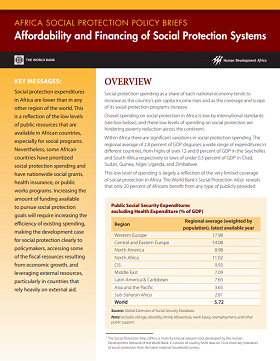
Africa Social Protection Policy Briefs – Affordability and Financing of Social Protection Systems
Report
Social protection spending as a share of each national economy tends to increase as the country’s per capita income rises and as the coverage and scope of its social protection programs increase. Overall spending on social protection in Africa is low by international standards (see box below), and these...

Market Analysis Guidance (MAG)
Report
The Market Analysis Guidance (MAG) suggests processes and tools aimed at integrating market analysis into the different phases of the project cycle, taking the existing Red Cross and Red Crescent (RC/RC) Movement’s technical documents into account whenever possible. The MAG was commissioned and...

Disaster Response: Mobile Money for the Displaced
Report
Advances in mobile technology have opened up new opportunities, not only for communication, but also for using the mobile handset as a platform for a range of applications. The introduction of data transfer facilities and the rise of mobile financial services around the world have allowed mobile money...